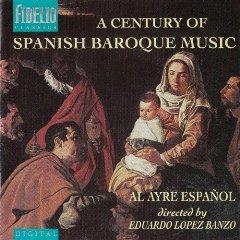Century Of Spanish Baroque Music (1992)
Century Of Spanish Baroque Music (1992)

Antonio de Literes - Ha Del Rústico Pastor 1 Introducción 1:42 2 Recitado - Aria 3:56 3 Recitado - Aria 4:06 4 Recitado - Minuete - Grave 3:46 Anonymous 5 Pascalles I-II 3:41 Joaquín Martínez de la Roca - Los Desagravios De Troya 6 Despacio - Solo Con Violines - Recitado - Seguidillas 3:09 7 Recitado - Solo Con Violines - Seguidillas 2:20 8 Aria - Recitado - Solo Con Violines - Recitado - Seguidillas - Minue 5:29 9 Primera Jornada: Recitado - Aria 6:04 10 Segunda Jornado: Recitado - Coplas 4:28 Francisco José de Castro - Sonata Prima 11 Preludio 2:10 12 Allemanda 1:46 13 Corrente 1:28 14 Giga 1:09 15 Minue 0:47 José de Torres Martínez Bravo - !O, Quién Pudiera Alcanzar! 16 Aria 3:45 17 Recitado - Aria 3:13 18 Despacio 2:38 19 Fuga 1:17 20 Recitado - Aria 3:20 21 Grave 1:53 Al Ayre Español (Ensemble) Eduardo López Banzo – conductor
In many works, Spanish Baroque music is a mixture of both school and popular music. Rhythms, color, instrumentation, melody and even the harmonic support have a little arabian touch. It developed mostly through popular music, not court music. Then, it was assimilated into the Spanish tradition. The 18th century Spanish were still impressed by the polyphony of the 16th century and continued to compose in that style.
Spanish composers such as Sebastián Durón (1660-1716), Antonio Literes (1673-1747) and José de Torres (c.1670-1738) used combined rhythms. Literes have a quartet of four voices, each singing a different rhythm with accents falling in different places. Many Spanish composers at that time were not satisfied with the rhythm of the bass and the voice, and added a lot of rhythms with the continuo and the percussion.
Complex rhythms which include a flamenco drum player, for example, recreate this atmosphere. The rythmic changes in Spanish baroque music are constant. The pizzicato string continuo played like guitars, the castanets, the descending tetrachords typical of the malagueña mixed with classic galant always excite the listener. --- geocities.ws
download (mp3 @320 kbs):








